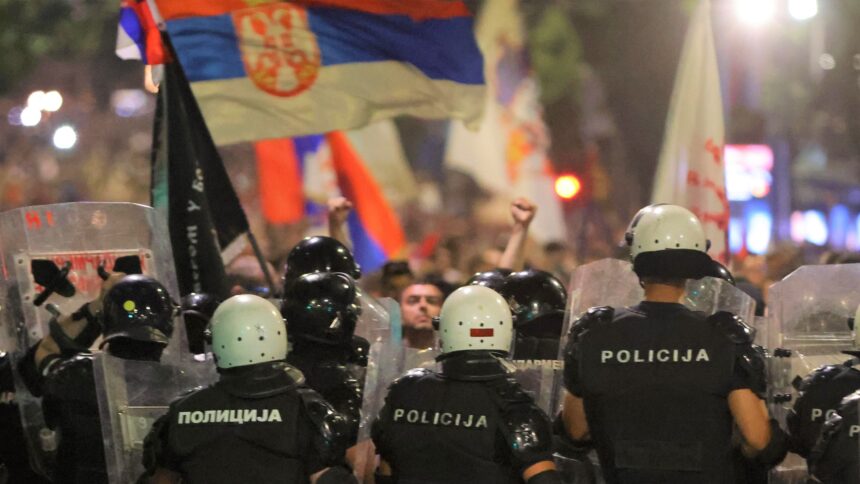Introduction
Belgrade police clash erupted on Saturday as more than 140,000 students, farmers, teachers, and workers took to the streets demanding early elections and an end to President Aleksandar Vucic’s 12-year rule. A peaceful rally transformed into clashes with tear gas, stun grenades, and dozens of arrests, highlighting deep political fractures in Serbia.
From Tragedy to Mobilization
The protests began in December 2024 following the collapse of a railway station canopy in Novi Sad, which killed 16 people. Investigations revealed structural negligence and corruption. Students responded by staging silent protests and campus shutdowns, spreading nationwide to include major cities like Niš and Kragujevac. According to Reuters, these actions culminated in Saturday’s mass demonstration in Belgrade (Reuters).
Record-Breaking Turnout and Clashes
Police initially reported around 36,000 attendees, while independent analysts estimated over 140,000 people. Protesters marched across Belgrade’s central squares and bridges chanting “We want elections!” As dusk fell, tensions escalated when some groups threw bottles and flares at riot police. Authorities responded with tear gas and stun grenades. Reports indicate at least 48 officers and 22 protesters were injured, with around 77 individuals detained (AP News) belgrade police clash.
Government Accusations & Repression
President Vucic condemned the rally as part of a “foreign-backed coup” and vowed strict enforcement to restore order. Leading up to the event belgrade police clash, security forces detained several activists on terrorism-related charges. Interior Minister Ivica Dačić defended police actions, stating they acted with restraint under provocation (Reuters).
EU Concerns and Democratic Implications
The protest is Serbia’s most significant demonstration since the overthrow of Slobodan Milošević in 2000. As an EU candidate, Serbia faces growing pressure to improve democracy, media freedom, and rule of law. European Commission officials, including Marta Kos, have warned that civil unrest might affect accession talks (AP News).
Many protesters criticize the EU’s muted reaction, viewing it as implicit acceptance of Vucic’s authoritarian tactics (DW).
Voices from the Frontline
A farmer, Sladjana Lojanovic, told Reuters, “The institutions have been usurped… Elections are the solution, but I don’t think he [Vucic] will go peacefully.” Student leaders have threatened civil disobedience if snap elections are not announced. In Belgrade, protesters also temporarily blocked state media offices, calling for unbiased reporting and accountability (Reuters).
What Lies Ahead?
- The government may intensify arrests under anti-terror laws, citing last weekend’s violence.
- Universities across Serbia remain partially closed due to continued student actions.
- EU accession negotiations may hinge on Serbia’s response to civil rights concerns.
Political analyst Helena Ivanov warned that Serbia stands at a crucial crossroads: “A harsh crackdown could intensify protests, while a concession may diffuse tension ahead of 2027 elections.”
Conclusion
The **Belgrade police clash** with over 140,000 protesters represents a watershed in Serbia’s democratic evolution. Born out of tragedy and fueled by student leadership, the movement’s strength reflects widespread discontent. Its path forward depends on whether the government opts for reform or repression, and how the EU responds to this critical democratic test.
Stay updated on democracy developments in Eastern Europe: Eastern Europe Democracy Watch.


